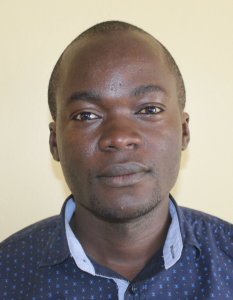April, 2021: Jimarani Primary School Project Complete!
Jimarani Primary School in Kenya now has access to a new source of safe, clean water thanks to the completion of their rain tank, which can collect 75,000 liters of water! We installed new latrines and handwashing stations for students, and we trained the school on improved sanitation and hygiene practices, including COVID-19 prevention. These components work together to unlock the opportunity for these students to live better, healthier lives.

Students pose at the new rain tank.
"The fact that we can now access clean and safe water, the levels of hygiene will improve in the entire school and health issues will be minimal compared to the past. School developments will progress effectively, thus promoting good academic performance," said pupil Centrine.
"Being a pupil at this school, I will have enough time to concentrate on my studies, and even the entire school will too, leading to improvement of school performance in different activities such as sports, academics, and the agricultural program."

Enjoying water from the rain tank.
Teachers were just as excited as the students about the new rain tank on campus.
"Access to clean and safe water will promote good health and long life, therefore, minimizing frequent visits to the hospital seeking treatment. It also empowers individuals as the little money they have is used to support developments in school or at home," said teacher John Kosgei.
"Time will be created for me to work on the progress of the school, students will no longer carry water from home, and we will not have to buy it from vendors. Access to clean and safe water will provide the school with a good working environment and good water for consumption purposes. It will also help in carrying out manual cleaning, thus improving the standard of hygiene."

A student takes a drink from the rain tank.
How We Go From Ground to Rain Tank
Construction for this 75,000-liter rain tank was successful!
Parents, staff, and students helped our artisans gather everything needed for construction. The school’s kitchen staff and a few parents helped provide meals for the artisans, while the school provided the artisans’ accommodations. Local women and men helped our artisans with their manual labor, too.

Excavation
The process officially began with our staff and school administration looking around the school compound to determine the best location for a new rain tank. This needed to be the best site with enough land and a nearby building with good, clean roofing to catch the rainwater.

Laying the stone foundation
Then, we cleared the site by excavating the soil to make level ground for the tank foundation. We cast the foundation by laying big stones on the level ground and reinforcing them using steel wire, concrete, and waterproof cement. We affixed both the drawing pipe and the drainage pipe as we laid the foundation.

Wire wall form with tap and drainage pipes set in front
Next, we formed the walls using a skeleton of rebar and wire mesh with sugar sacks temporarily tied to the outside as backing. We attached this to the foundation’s edges so that the work team could start the Ferro-cementing process. They began layering the walls with cement, alternating with the inner and outer side, until six cement layers were in place. (The sugar sacks are removed once the interior receives its first two layers of cement.)

Interior cementing
Inside the tank, we cast one central and four support pillars to ensure the dome does not cave in once cemented. Meanwhile, we plastered the inner wall while roughcasting the outer walls. We dug and plastered the access area to the tap outside of the tank, where we also installed a short staircase. In front of the access area, we constructed a soak pit where spilled water can drain from the access area through the ground. The pit helps to keep the tap area dry and tidy.

Pillar work
Dome construction could begin after the tank walls settled. We attached a dome skeleton of rebar, wire mesh, and sugar sacks to the tank walls before cementing and plastering it using similar techniques as the wall construction. We included a small manhole cover into the dome to allow access for future cleanings and water treatments.

Sewing sacks to wire to form the dome support.
We propped long wooden poles (about 75 of them!) inside the tank to support the dome while it cured. Then it was down to the finishing touches: fitting a lockable cover over the tap area, affixing the gutters to the roof and tank, and setting an overflow pipe in place at the edge of the dome for when the tank reaches capacity.

Completed rain tank with water flowing
Once finished, we gave the rain tank three to four weeks to undergo complete curing. Finally, we removed the interior support poles and dome sugar sacks and cleaned the tank.
We officially handed over the rain tank to the school directly following the training. Students and staff celebrated the presence of clean water on campus. The event was an excellent chance for us to acknowledge the school administration and students as the primary parties entrusted with the tools we have given and remind them of our continued support as they develop. Happiness, thanksgiving, and appreciation were the order of the day flowing in all directions.

A student enjoys a drink from the rain tank.
VIP Latrines
This project funded the installation of six new ventilated improved pit (VIP) latrines, three for the girls and three for the boys. These new latrines have cement floors designed to be easy to use and clean, locking doors for safety and privacy, and vents designed to keep air flowing up and out through the roof. With a rain tank right on school property, there should be enough water to keep them clean.

Boys pose at their new latrines.
Handwashing Stations
The two handwashing stations were set up during training and handed over to the student health club. These were placed outside of the girls’ and boys’ latrines to encourage handwashing after latrine use. Health club members will teach other students how to wash their hands at the stations properly, make sure the stations are filled with water, and ensure that there is always a cleaning agent such as soap or ash available.

Handwashing outside the new girls' latrines.
New Knowledge
We scheduled hygiene and sanitation training with the school’s staff, who ensured that the training date would be convenient for pupils and teachers. When the training day arrived, lead field officer for the project Victor Musemi
deployed to the site to lead the event. 22 people attended the training, which we held outside within the school compound.

Handwashing demonstration
We focused on COVID-19 prevention, transmission, and symptoms while also covering several other topics. These included personal hygiene such as bathing, oral hygiene, and the ten steps of handwashing; environmental hygiene; child rights; operation and maintenance of the rain tank, latrines, and handwashing stations; and leadership and governance. During the latter, the students elected their peers to lead their newly formed student health club.

Students practice contactless greetings at training.
The club will be significantly involved in the water, sanitation, and hygiene project management at school. It will be responsible for encouraging good health and hygiene practices amongst their peers, teachers, and the larger community. We involved stretches, dances, and physical activities between each topic to keep the pupils’ energy up and their minds active. By the end of the training, each pupil understood their role in sustaining clean water and good health within their school community.

Dental hygiene demonstration
"Knowledge is power as far as hygiene and sanitation skills are concerned. I know I am in a better position to help others. This will also help me to understand the importance of living a healthy life and also minimize the risk of contracting the bacteria-caused diseases through poor hygiene," said student Careen.

Pupil Careen
"This is one of the wonderful moments in my life. I really appreciate and thank God for this opportunity. The hygiene standards will improve. I will get more time to learn, hence improving my academic performance and this will also contribute to a healthy life," said pupil Collins after attending training.
We asked Collins what it was like to be at home for most of the last year due to Kenya's national coronavirus-related school closures and what it has been like coming back to school.
"The school closings really affected learning activities such as exams; no pupils could move to another level. School life is important to me. I like socializing with friends, sports being part of my life, being taught by teachers, and more so, mathematics contests with other schools," Collins said.
"I am so grateful being at school because it's given me hope about my future and more so it engages me with positive things that shape life and also let me advance to another class."

Fetching water from the rain tank
"The school administration had already trained pupils on basic skills like washing hands, sneezing using the elbow, and maintaining social distance amongst themselves. These have become a policy for the learners. To me, the measures taken into consideration are good for the learners. This will ensure that there is no spread of the virus amongst ourselves," Collins continued.
"As pupils of this school, from now henceforth, I will train others on matters concerning hygiene and sanitation skills to ensure that the COVID-19 virus cannot spread to our school and community where I come from."

Handwashing outside the boys' latrines.
When an issue arises concerning the water project, the students and teachers are equipped with the necessary skills to rectify the problem and ensure the water point works appropriately. However, if the issue is beyond their capabilities, they can contact our field officers to assist them. Also, we will continue to offer them unmatchable support as a part of our ongoing monitoring and maintenance program.
Thank you for making all of this possible!


 Rainwater Catchment
Rainwater Catchment
 Rehabilitation Project
Rehabilitation Project












































